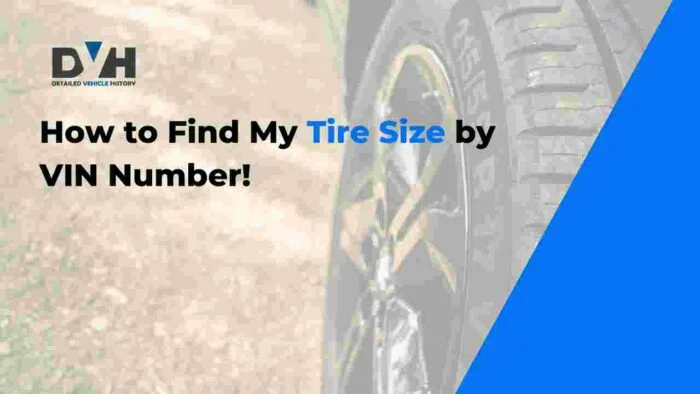Check Tire size by VIN
Buying replacement tires can feel overwhelming. You might ask yourself, “What size do I need?” Many people search for answers but struggle to find the right fit. This confusion can lead to incorrect purchases.
Luckily, your Vehicle Identification Number (VIN) can guide you to the exact tire size. This article will show you how to find tire size by VIN.
Can I Find the Tire Size by VIN?
Yes, you can find tire size by VIN. The VIN is like a car’s fingerprint, containing specific information including the tire size. You can find the correct tire size for replacements by decoding the VIN to reveal the car specifications.
By doing so, you can be sure that the replacement tires you get fit perfectly.
To check your tire size by VIN, start by locating your VIN.
Once you have the VIN, you can use a free VIN decoder to break down the VIN and get the tire size and other vehicle specs for your car. Alternatively, you can also get the full list of equipment of your car through a window sticker lookup tool.
READ ALSO: Chassis Number vs. VIN: Are They the Same?
Where to Find Your Car’s Tire Size
A car tire size can be found in the following places, on and off the car :
- Driver’s Side Door Jamb: This is the most common place to find your car’s tire size. Open the door and look for a sticker that lists tire information and a handful of other specifications of your car.
- The Vehicle’s Owner Manual: This usually contains a dedicated section for tires, including their sizes, recommended pressure levels, etc. If you don’t have the manual, you can download a PDF version from the manufacturer’s website.
- Tire Sidewalls: Additionally, you can check the sidewalls of your current tires to find the tire brand, name, and sizing codes. These sizing codes contain important measurements like width, aspect ratio, and diameter.
How to Decode the VIN to Find Tire Size
Follow these steps to find the tire size using our VIN decoding tool:
- Enter the VIN number into the form. Provide other details like the email address and phone number.
- Click “Search VIN” to breakdown the VIN for all the available information including the tire information.
- Find other key information like the transmission, engine, and more.
Decoding Tire Size Terminology
Understanding tire size terminology is crucial. Tire sizes follow a standard format, like P215/65R15. Here’s how to decode it:
- The letter at the beginning indicates the tire type. For example, “P” stands for passenger cars.
- The first number (215) represents the tire width in millimeters.
- The second number (65) is the aspect ratio. It shows the tire’s height as a percentage of its width.
- The letter “R” stands for radial construction.
- The last number (15) indicates the wheel diameter in inches.
Knowing this terminology helps you make informed choices when shopping for tires online.
If you prefer an instant solution, use a VIN decoding tool. A quick search can reveal your vehicle’s original tire size. Just enter your VIN to get accurate information.
READ ALSO: How to Check Rotor Size by VIN Number
Factors to Consider When Choosing Correct Tire Size
There are several factors to consider when selecting tire sizes for your car. Two key factors include:
- Driving Habit: Your driving habits and routes that you take on a regular basis matter a lot. If you drive on highways most of the time, going with the standard tire size is the way to go. Alternatively, going with smaller or bigger tires can also serve different purposes like driving offroad or making your car sit slightly lower on the ground for accessibility.
- Climate: If you live in an area with heavy rain or snow, you may need to adjust tire sizes and the type of treads they have.
Why Choosing the Correct Tire Size Matter?
Choosing the correct tire size is essential for several reasons:
- It affects your vehicle’s handling and performance. Incorrect tires can lead to poor handling and increase the risk of accidents.
- The wrong tire size can significantly affect fuel efficiency. Tires that are too large or too small can cause your engine to work harder. This results in lower fuel economy, costing you more at the pump.
- Using the correct size extends the lifespan of your tires. Properly sized tires wear evenly and last longer. This means fewer replacements and savings over time.
READ ALSO: VIN Build Sheet: What It Is and How to Get One
Tips for Tire Maintenance
Maintaining your tires is as important as choosing the right size. Some of the tips to keep in mind are:
- Regularly check your tire pressure. Under-inflated tires can cause excessive wear and lower fuel efficiency.
- Rotate your tires every 5,000 to 7,500 miles. This helps them wear evenly. Inspect your tires for signs of damage, such as cracks or bulges.
- Keep an eye on the tread depth. Use the penny test: insert a penny into the tread with Lincoln’s head down. If you can see the top of his head, it’s time for new tires.
By following these maintenance tips, you can extend the life of your tires and improve overall vehicle performance.
RELATED: Efficient Car Maintenance Schedule by Mileage or Time
Conclusion
Finding your tire size by VIN is simple and straightforward. With the right information, you can make confident decisions when purchasing replacement tires. Remember to check your vehicle’s specifications and consider your driving needs.
Don’t hesitate to use our VIN check tool to find the accurate tire size by VIN. It can save you time and ensure you get the correct tire size.
With the right tires and proper maintenance, you can keep your vehicle safe and performing at its best. If you’re buying a used car get a full VIN number check to be sure the vehicle is in good condition and not a lemon.
Frequently Asked Questions
Tires do not have VIN numbers. However, they have a DOT number. This number provides information about the tire’s manufacturer and production date.
You can identify a tire by its size, brand, and DOT number. Each tire has a unique identifier that helps determine its specifications.
The last number in the size format (like P215/65R15) indicates the diameter in inches. So, in this case, the tire diameter is 15 inches. You can also check your vehicle’s owner’s manual for this information.









